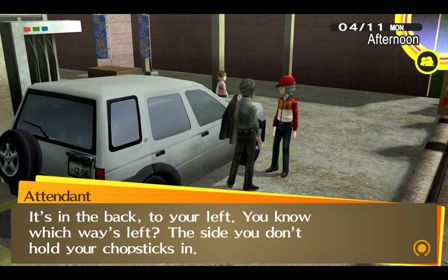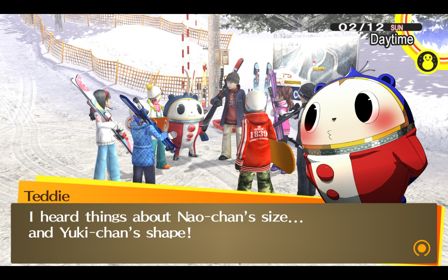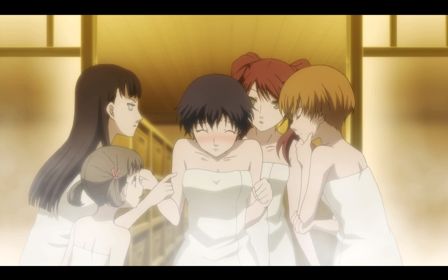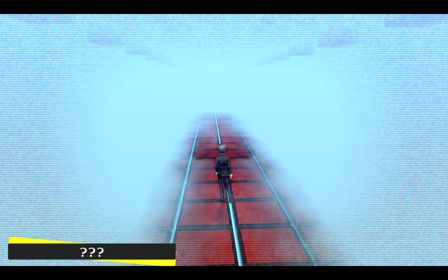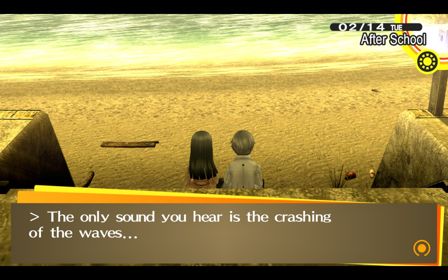Persona 4 Golden (2012)
Violent programming.
Even when I was young, living as a youth in the real world, I wanted a life sim that let me play as a teenager. I envisioned it as an open world where my high school character did high school, teenager things.
A game eventually came along that matched this picture in my head. That game was called Bully. But the second closest match was when I discovered the Persona series, which I entered via Persona 5 on my PlayStation 4. And what an unforgettable, memorable, ungodly fucking long game Persona 5 was. Persona 5 was so long, I found gray hairs after I finished it. The length made me worry about how I’d looked after playing any other Persona games.
Yet here I was, impulse buying Persona 4 Golden during a Steam Sale. “Okay,” I said to myself, as I added it to my Shopping Cart. “You’re the one who will need the AARP subscription.”
Persona 4 Golden puts you in control of a typically silent, fill-in-the-blanks-personality JRPG Main Character. He’s also the only character in your party you’re allowed to name.
I typed in my real name, first and last, when prompted. I didn’t realize until about 20 hours in that that I’d missed a golden (ha!) opportunity to name him something better, like H3ir0 or SuHn GOKKUU. But 20 hours is way too long to restart over something so trivial, so I’d have to deal with being a Japanese kid with an American name.
Main Character’s parents are busy working overseas, so they send him to live in the fictional Japanese country town of Inaba for a year. Inaba is a friendly place, but with emerging issues. For instance, the new local not-Walmart is forcing the small business owners to board up their buildings. Stardew Valley time, ronins.
Of course, that’s before the murders start. But I’ll get to that in a minute.
Main Character moves in with his uncle, Ryotoro, and seven-year-old cousin Nanoko. Ryotoro is an exhausted homicide detective, which means many late nights absent from the home. This leads to an atypical living situation where little Nanako runs the whole house, doing the cleaning and cooking all the food.
MC is quick to make friends at his new high school. At first glance, they all fit into typical JRPG/anime archetypes. There’s Yosuke, the everyday, underachieving best friend guy; Chie, the hypershrill Monk-class girl; and Yukiko, the awkward, sheltered shrine maiden. Later on, the party expands to include Rise, a former teen celebrity who wants a normal life; Kanji, who puts on a tough guy act to hide his sensitive side; and Naoto, a child prodigy genius detective.
Then people start getting murdered, the victims posed in creepy serial killer ways. Not long after that, the characters discover an alternate dimension behind television screens. Within this world exist Shadows, the dark parts of the unconscious that we cast off. The killer is throwing victims into the TV, relying on the hostile Shadows as the weapon of choice.
In the plot’s early stages, Main Character’s new friends must face their Shadows as dungeon bosses. By defeating, and accepting, the Shadow as the part of themselves they’ve disavowed, it becomes that character’s Persona. Personas are like Stands from Jo Jo’s Bizarre Adventure, a psychic manifestation of the character’s resolve transformed into an entity. Personas allow characters to perform melee and magic attacks in battle, with a specific element tailored to each. So, Yosuke uses Wind, Yukiko Fire, Chie Ice, and so on.
Only Main Character, the ‘Wild Card,’ can equip different Personas. By collecting them like big Pokemon, he can fuse them into much stronger Personas later. As Personas level up, he can equip different elemental magic to them as well.
Oh, it’s also in the Shadow World that the characters meet a plump furry mascot in a zippered bear costume. Teddie is everyone’s initial guide through the Shadow World. He has an idea of how it works, enough to convey all the metaphysical concepts to the player. However, he has no memory of his origins.
Later, Teddie steps outside the TV, an endeavor which eventually allows a human-blond-sort-of-person to emerge from the costume. As an entity not of Earth, he embodies a socially inept archetype, unaware of our mores and social taboos. Sometimes that reaches the point of absurdity. Like, too absurd. Like, hitting on the seven-year-old at every opportunity is a bit weird, dudes. I never agreed on how to feel about Teddie, except for when I wanted to throw my controller at the screen.
The Persona 4 experience is divided into two parts, the regular, mortal human realm, and the dungeon-crawling Shadow World. On the Inaba side, Main Character goes through teenager rites of passage like attending classes or hanging out with friends. The Shadow World is where all the fighting and leveling up happens.
Building relationships on the highschooler side is very important. By hanging out with the characters enough, getting them to like you more, you unlock helpful abilities for them in battle. Strengthening bonds is also the key to crafting stronger Personas.
But there’s only so much time for socializing, which is why spending it wisely is also quite important. The game follows a calendar with a set number of days, with story events scripted to happen on specific dates. Choosing to do any extracurricular activity passes a part of the day. If you do not rescue the Shadow World victims before that certain scripted day, they die, and it’s game over.
Fortunately, there’s plenty of room to finish the dungeon crawling and rescuing. Unless you lack time management skills, it never feels like too tight of a rush. The best strategy is to finish dungeons as fast as possible so you can play Sim Teenager.
Now, on the other side of my own Steam Deck screen, social interaction could be the scariest part for me. But it’s not that hard to stay on good terms with friends in Persona 4. Dialogue choices are never morally gray, though it is important to pay attention to what characters say to determine the best options. Reading the room, so to speak. When my ADHD wasn’t at its worst, I picked the options that made me sound the least like a douchebag. It always comes down to Nice, Dick, or Apathetic—the old BioWare way.
In addition, interacting with Main Character’s friends allows them to develop past their aforementioned archetypes, so they feel more like real people. Everyman Yosuke needs help grieving after his friend’s death. Shrine Maiden Yukiko can’t decide between striking out on her own or inheriting the family inn. Sensitive Tough Guy Kanji discovers a hobby that challenges his masculinity. Main Character becomes involved in much deeper arcs for everyone, that we otherwise wouldn’t see if we ignored them.
And while all of this is a lot of fun, one’s mileage may vary in how many decisions they want the game to make for them. This is especially true at the beginning, a four-hour tutorial session that consists of clicking through dialogue and anime cutscenes.
There were many places where Persona 4 made decisions for me. For instance, before transitioning to the next crucial plot point, it might tell me, “You decide it’s best to go to sleep.” Excuse me? How about no, I didn’t. I drank forty cups of coffee, ran screaming around the neighborhood, and threw up in Teddie’s fursuit. The game is like the worst kind of Dungeon Master in that way.
All that adds up to a potential dealbreaker. Inaba is an open world, until it isn’t. As much as the game lets you interact with that world, it is following a script. That brings up the issue of the dirty L-word, linear. Persona 4 Golden strikes a strange duet of letting you make choices while it rides on rails.
I can’t say Persona 4 Golden was the most elusive of whodunit murder mysteries, either. I guessed who the murderer was rather early on. When I had my suspicions confirmed at that climactic moment of reveal, I wasn’t that surprised; it was more of a ‘why’ rather than a ‘who.’
But that doesn’t mean the story isn’t engaging. The mystery kept me curious enough that it was hard to put the game down. In the interest of avoiding accidental spoilers, I abstained from Googling stuff (i.e. “Do you think Teddie is a creep, too, Reddit?”) It was like getting involved in a good TV show. Which is fitting.
Like Persona 5, Persona 4 Golden is a long game. The final time on my save file was somewhere around 85 hours, which doesn’t factor in deaths and section replays. A lengthy experience is to be expected. The game’s original release was during the PlayStation 2 era, when 100 hours’ minimum was required to market new titles as epic thrill rides. But I’m getting older every day, and the years go by faster every January. Long games exhaust me. But unlike Persona 5, the game ended right when it needed to, just as I was ready to move on. It did not wear out its welcome.
The difficulty wasn’t too painful, either. For a majority of the game, I got away with a minimal amount of leveling up before boss fights. Through simple dungeon progression, with some resting in-between, I was always powerful enough to move the story along.
That is, except for one particular boss, who taught me humility via an ass whopping. Now a point of no return would’ve been quite annoying after 40 hours, but this thankfully wasn’t the case. Flipping the tables on this fiend just meant leveling up a lot more.
Then one incorrect dialogue choice earned me a mediocre, unsatisfying ‘bad’ ending. Fortunately, there’s an option to save beforehand. After searching walkthroughs and comments to figure out my mistake, I reloaded and clicked the right thing.
This isn’t just pivotal for achieving the better ending. It also locks you out of playing through the final dungeon and hours of content after the fact. It was frustrating, since I’d spent the entire game paying close attention, so I wouldn’t stumble into being a dick. On the other hand, I get it. The dialogue choice is about Main Character and friends taking a step back to think harder. But man, what a blow.
So, I finished the game and got the good ending. However, I realized too late I wouldn’t get the good good ending, added after Atlas rebranded the original Persona 4 as Persona 4 Golden. All those comment sections insisted the Golden ending is the best and most awesome ending anyone could ask for. I don’t know anything about it, though. I just got the plain Persona 4 good ending and did not spoil what else could’ve happened for myself.
Which means, of course, that I plan to play Persona 4 Golden again one day. The game is of such quality that I’m willing to dedicate another hundred hours to it. And if you like lifesims and JRPGs, you should check it out for yourself as well. Persona 4 Golden left me feeling good. I want to hang out with these people again, to solve the mystery of Main Character’s golden ending for myself.
Final Rating: ***
